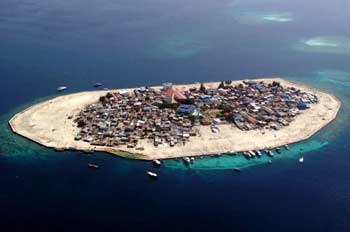Environment
News, Articles and Reports
Islands sharing same
lagoon affected worst by tsunamis
Bluepeace
The tsunamis’ impact on islands of the
Maldives is presumably highly individualistic
for each island, but a broad pattern of geomorphologic
impact can be observed, writes Ali Rilwan, co-founder
of Maldives’ first environmental NGO Bluepeace
Maldives.
 |
Kandholhudhoo
in Raa Atoll, which was evacuated after
the waves hit
|
Extreme events, particularly high waves and
storms, play a vital role in the pattern of
island accumulation and island erosion in the
atolls of the Maldives.
The morphology and dynamics of islands are
thus a function of prevailing pattern of extreme
events. However, there appear to be few instances
where atolls in the Maldives were affected by
storms and high waves.
It is also believed the depth of the surrounding
seas, and slopes to shores of an atoll and tide
level, determine height and strength of the
tsunamis that hit the islands of the Maldives
on 26 December 2004. In addition, low-tide at
the time of the tsunamis striking the islands
could have played an important role in minimizing
the destruction on the islands.
Islands in an atoll separating each others
with deep channels reduce the devastating impact
of tsunamis and many such islands escaped without
much or any damage. In deep channels, the tsunamis
simply rushed through the channels, and waves
did not even reach high tide marks on islands
adjacent to deep channels.
This was observed in Raa Atoll where most of
the islands are situated with relatively small
lagoons and deep channels separating each other.
Kandholhudhoo in Raa Atoll, which was evacuated
after the waves hit, is an exceptional case.
The island had already suffered monsoon flooding
and swells due to the combination of reclaimed
shoreline and mined reef. The large population
pressure on this island has led to the reclamation
up to the coastal area in all directions beyond
the local reef, known as the “house reef”.
A handful of islands in different atolls in
the Maldives affected by the killer tsunamis
can also be listed in the same category as Kandholhudhoo
as these islands have reclaimed and modified
its coastal zone. Like Kandholhudhoo, the coastal
area of the capital island of Male has been
reclaimed. However, the seawall and the breakwaters
may have reduced the devastating impact of the
tsunamis.
When the tsunamis struck the islands, dense
coral reefs in large lagoons could not help
to reduce the devastating impacts of tsunamis
by absorbing some energy of the waves. Islands
that were worse affected are islands that are
in a same lagoon and islands with a large lagoon.
Large lagoons have acted as big land masses
on which waves can crest resulting in them hitting
the islands in the same lagoon with greater
force and height, destroying homes and infrastructure.
The human tragedy in these islands has been
horrendous. Quite apart from the terrible loss
of life, means of livelihood of thousands have
been destroyed. Almost two-thirds of the fatalities
were in Meemu, Laamu, Thaa and Dhaalu atolls.
Most of the islands in these atolls are either
in a same lagoon or with a very large lagoon.
It is also believed the depth of the surrounding
seas also determined the height and strength
of the tsunamis. And many believe that it was
the main reason why, on some islands especially
in the far South with deep seas, escaped with
minor or no damage at all. Due to these geological
features, the tsunamis hit the islands in Huvadhu
Atoll and Addu atoll more like a tidal surge
of less than a meter’s height.
Ecological damages to some of these islands
throughout the archipelago are catastrophic.
There is also fear that the substructures of
many islands have been damaged. Crops and introduced
vegetation on many islands were totally destroyed
by salt water.
|